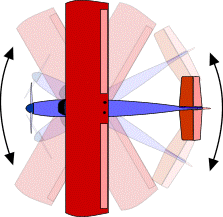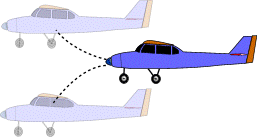

| Primary Flight Control 1 |
Main Parts & Controls of an Aircraft

The primary flight controls on any aeroplane are:
Pitch : Roll : Yaw : Throttle
The following descriptions give an explanation of the effect of each control in isolation, for a theoretical aircraft. Obviously in flight, control are operated together, and there are also secondary effects of controls to consider.
| Pitch Pitch changes raise or lower the nose of the aircraft. This effect is caused by the operation of the elevator. As the elevator is raised, the force of the airflow pushes the tail down, rotating the aircraft about the balance point and raising the nose. |
 |
| Roll
Roll is a rotation around the long axis of the fuselage. This effect is caused by the operation of the ailerons. To roll left, the left aileron is raised and the right aileron lowered. The combined effects of the airflow on the controls lifts the right wing and lowers the left wing. The operation is reversed to roll right. |
 |
| Yaw
Yaw is a horizontal rotation around the vertical axis of the aircraft, and is initiated by the rudder. If the rudder is deflected left, the pressure from the airflow pushes the back around and the aircraft rotates around the vertical axis. Right rudder makes it rotate in the opposite direction. In the absence of any other control inputs, the aircraft will carry on the original direction of flight but with a sideways motion; it will only turn as a consequence of the secondary effects of controls. |
 |
| Throttle
Controls the amount of power the engine produces. Contrary to what you may see at the flying field, most models are not required to be flown around at full throttle all the time! Opening the throttle will cause the aircraft to speed up, thus creating more lift, resulting in a climb. Closing it will cause the aircraft to slow down, reducing the lift and hence making the aircraft descend. |
|
Now you have seen how the control surfaces affect the flight path of the
model, you can read about how the radio operates the control surfaces.
| Secondary Effects of Control |
None of these controls actually work in isolation, whenever a control is applied, there are always secondary effects which influence the reaction of the aircraft.
Pitch - Elevator:
If the elevator is used to pitch the nose of the aircraft up, this has the secondary effect of increasing the angle of attack of the wing and so more lift is generated which will make the aircraft climb, however at the same time the change of attitude will increase the drag of the aircraft which will tend to slow it down and cause it to descend. So, provided the engine output remains the same, the secondary effects of the elevator are to control the speed of the aircraft.
Roll - Aileron:
If the stick is moved to the left the aircraft will bank to the left. As the lift always acts at 90º to the wing, and weight always acts straight down, the resultant imbalance of forces causes the aircraft to sideslip to the left.
This sideslip causes a flow of air towards the fuselage sides. As there will be more area behind the Centre of Gravity than in front of it, the resultant force will tend to rotate the aircraft causing it to yaw.
Yaw - Rudder:
Application of the rudder causes the model to yaw from side to side. This yaw means that the wing on the outside of the turn is moving faster through the air, while the inside wing moves slower. This speed change generates more lift from the outside wing and less from the inner, causing the aircraft to roll in the direction of the turn. The application of rudder then, causes first a yaw, followed by a roll. It is this secondary effect that allows aileron-less rudder only models to be controlled.
These pages have been contributed by Phoenix Model Flying Club, Lowestoft, Suffolk
